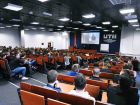AT THE AIRPORT
Airports are torture chambers if you’re claustrophobic. It’s not just the threat of the ride ahead
– being stuffed into seats like sardines and then catapulted through the air in a narrow metal
tube – but also the terminals themselves, the crowds of people, all the motion and noise, and
the whole thing sealed off by glass windows like some kind of a horrible ant farm. This is just
one of the many things that Hadley is trying not to think about as she stands before the ticket
counter. She can feel something miserable inside her. Part of it is the flight to London awaiting
her and part of it is the airport itself, but to make matters worse there is the realisation that
she’ll now be late for the wedding she didn’t even want to go to in the first place, and something
about this sad little twist of fate makes her feel like crying.
She’s spent the past few weeks secretly wishing this very thing might happen, though
admittedly, her fantasy scenarios have been a bit more dramatic: a massive airline strike;
an epic hailstorm; a failure of all of the plane’s engines. All perfectly good reasons why she
might have to miss her father’s walk down the aisle to marry a woman she’s never met. But
being late for your flight seems just a little too convenient, maybe a bit suspicious, and Hadley
isn’t at all sure that father will understand that it wasn’t her fault.
“I’m sorry, Miss,” one of the gate attendants says. “There’s nothing we can do but try to get
you on the evening flight.” Hadley nods her head. The attendant is now working the keyboard
of her computer with a kind of violent intensity, punching at the keys.
“You’re in luck,” she says. “There is one free seat available.”
Hadley is almost afraid to pose the question, but she asks it anyway, “What time does
it reach its destination?”
“Nine fifty-four, tomorrow morning.”
Hadley pauses for a moment and says, “I suppose I’ll have to take it.”
“Boarding will start from this gate at seven-thirty tonight and the plane leaves at eight-fifteen,”
the attendant says, handing over the papers, which are all neatly bound in a little jacket.
Hadley goes towards the windows and examines the rows of grey chairs, most of them
occupied. She puts her backpack on top of her carry-on suitcase. The smell of butter from
a nearby pretzel stand is making her slightly sick. She wishes she could just call off her flight,
take a taxi and go home but she knows she can’t do it. She also knows that it’s a holiday
weekend so there won’t be any other free seats, and the weather maps on the TV screens
show a whirling pattern of storms approaching. There are suitcases on empty chairs, families
camped out around corners, greasy McDonald’s bags scattered across the floor. Finally, she
spots an empty seat and she hurries in that direction.
adapted from The Statistical Probability of Love at First Sight by Jennifer E. Smith
![]()


